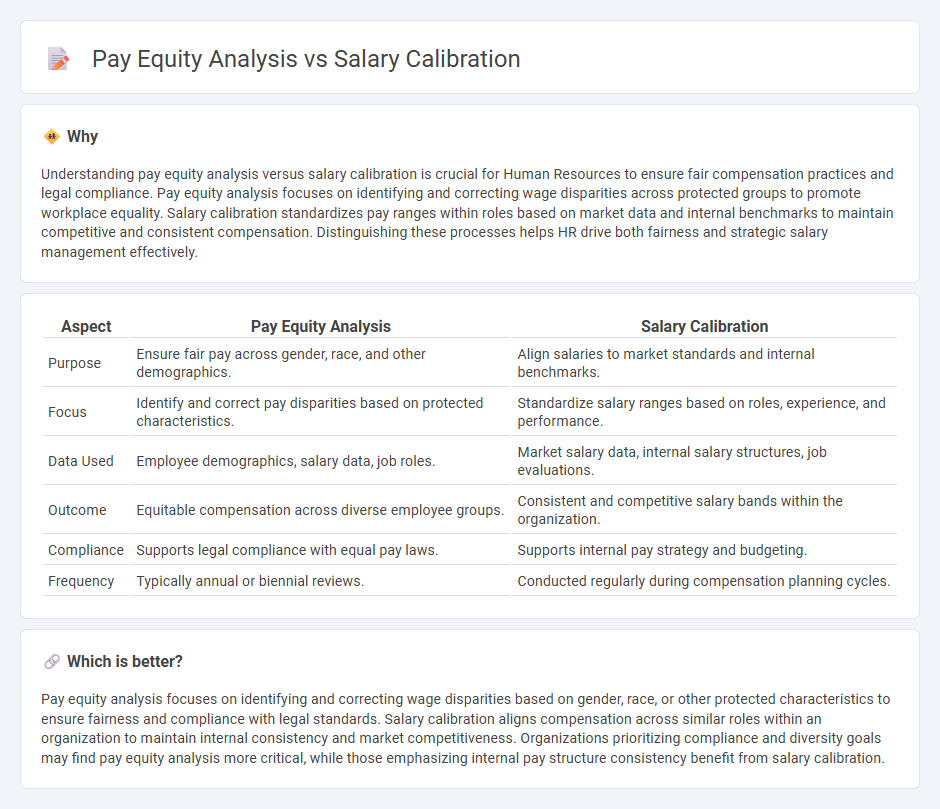
Pay equity analysis identifies disparities in compensation based on gender, race, or other demographics to promote fairness and compliance with equal pay laws. Salary calibration aligns employee pay ranges with market standards and internal job evaluations to maintain consistency and competitiveness. Explore effective strategies to balance these approaches and enhance your organization's compensation practices.
Why it is important
Understanding pay equity analysis versus salary calibration is crucial for Human Resources to ensure fair compensation practices and legal compliance. Pay equity analysis focuses on identifying and correcting wage disparities across protected groups to promote workplace equality. Salary calibration standardizes pay ranges within roles based on market data and internal benchmarks to maintain competitive and consistent compensation. Distinguishing these processes helps HR drive both fairness and strategic salary management effectively.
Comparison Table
| Aspect | Pay Equity Analysis | Salary Calibration |
|---|---|---|
| Purpose | Ensure fair pay across gender, race, and other demographics. | Align salaries to market standards and internal benchmarks. |
| Focus | Identify and correct pay disparities based on protected characteristics. | Standardize salary ranges based on roles, experience, and performance. |
| Data Used | Employee demographics, salary data, job roles. | Market salary data, internal salary structures, job evaluations. |
| Outcome | Equitable compensation across diverse employee groups. | Consistent and competitive salary bands within the organization. |
| Compliance | Supports legal compliance with equal pay laws. | Supports internal pay strategy and budgeting. |
| Frequency | Typically annual or biennial reviews. | Conducted regularly during compensation planning cycles. |
Which is better?
Pay equity analysis focuses on identifying and correcting wage disparities based on gender, race, or other protected characteristics to ensure fairness and compliance with legal standards. Salary calibration aligns compensation across similar roles within an organization to maintain internal consistency and market competitiveness. Organizations prioritizing compliance and diversity goals may find pay equity analysis more critical, while those emphasizing internal pay structure consistency benefit from salary calibration.
Connection
Pay equity analysis identifies compensation disparities across employee groups based on gender, race, or other factors, ensuring fair wage distribution in organizations. Salary calibration uses these insights to adjust salary ranges and align compensation with market standards and internal equity, promoting consistent pay practices. Both processes are crucial for fostering transparency, employee trust, and compliance with labor regulations.
Key Terms
Benchmarking
Salary calibration aligns employee compensation with market benchmarks, ensuring competitive pay structures based on industry standards and role-specific data. Pay equity analysis examines internal compensation fairness, addressing disparities across demographics to promote inclusivity and compliance with legal standards. Explore how benchmarking integrates both approaches for a holistic compensation strategy.
Internal Parity
Salary calibration ensures internal parity by systematically aligning employee salaries within an organization based on role, experience, and performance benchmarks. Pay equity analysis goes deeper, examining compensation differences across demographic groups to identify and resolve disparities related to gender, race, or ethnicity. Discover how mastering both processes strengthens fair compensation strategies and fosters a more equitable workplace.
Pay Disparities
Salary calibration involves adjusting employee pay based on market benchmarks and job roles to ensure competitive compensation, while pay equity analysis specifically examines pay disparities among employees performing similar work with a focus on eliminating bias related to gender, race, or other protected characteristics. Pay disparities identified through pay equity analysis highlight systemic issues that salary calibration alone may not address. Explore comprehensive strategies to align compensation fairness and market competitiveness effectively.
Source and External Links
How to facilitate a calibration session successfully - Salary calibration involves calibration sessions during compensation reviews where managers align on performance ratings to ensure consistent and fair pay adjustments across similar roles and teams.
Calibration Specialist Salary in the United States (2025) - The average salary for a Calibration Specialist in the US is approximately $60,027 per year, with hourly wages around $28.86, indicating typical compensation for roles directly linked to calibration tasks.
Performance review calibrations: What you need to know - Salary calibration is closely tied to performance review calibration, a process where managers discuss employee ratings collectively to reduce bias and achieve consistency in evaluating performance that impacts compensation decisions.
 dowidth.com
dowidth.com